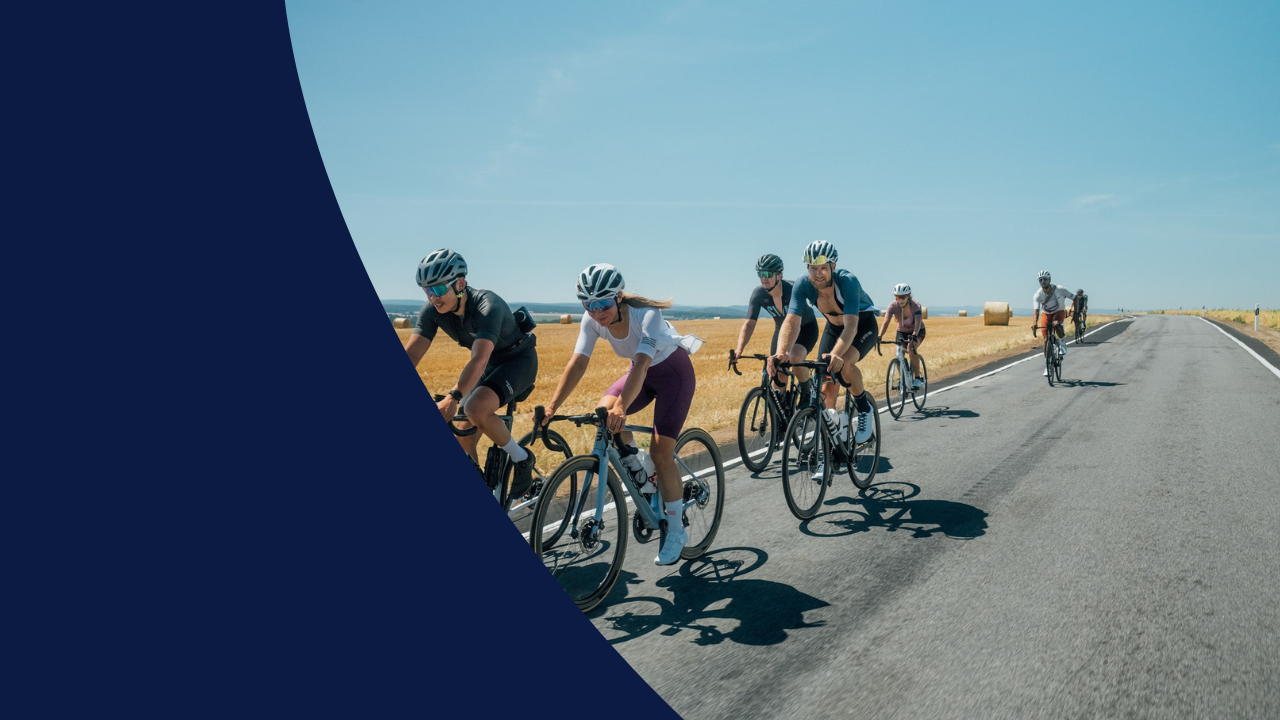Hello,
Here is Malte the founder of le melo. Let me tell you about one of the most important lessons I have learned in my career:
Training makes you weaker. Only recovery makes you stronger.
This simple truth is far too often overlooked in endurance sports. Don't get me wrong, hard training sessions are the key to success. But the real progress, the strengthening of your muscles and your body, takes place in the recovery phase.
After a strenuous workout, your body reacts to the strain and adapts to be even stronger in the future. How you handle this recovery phase will determine how effective your adaptations will be.
From yoga to healthy eating to massage, there are many ways to optimize your recovery process. Both from day to day and over the course of an entire season. Don't neglect this aspect, folks! Recovery is the key to achieving your next personal best.
The training principle: Why recovery is so important
Contrary to the promises of trendy workouts, training does not bring immediate or steadily increasing gains. Immediately after a training session, your performance - an indicator of your fitness - is actually reduced. Only after a recovery phase does your fitness/performance return to its previous level and even exceed it. This drop, followed by an upswing, is known as the training principle. The following graphic from "Training for the New Alpinism" and "Training for the Uphill Athlete" illustrates these phases of exhaustion, recovery and supercompensation.
In the exhaustion phase immediately after training, you are weakened and your performance is below your normal level. With sufficient recovery - through sleep, nutrition, hydration with Le Melo and active regeneration - you can restore your full performance.
The key is the supercompensation phase: As your body adapts to the training load, you exceed your previous fitness level. This cycle of overload and overcompensation must be repeated over and over again in order to constantly push your limits upwards.

In the period following a training session, which can last from an hour to several days, a cascade of physiological effects triggers adaptations in your skeletal and cardiac muscles as well as your biochemistry. The exhaustion you feel is the signal for these subcellular processes and ultimately leads to the training principle. Muscle damage and depleted energy stores - the constant companions of endurance athletes - are also the two strongest training stimuli. Essentially, the state of exhaustion teaches you how to deal with increasing training loads. And since endurance training means exceeding your current limit in workouts, endurance athletes live in a permanent state of fatigue.
However, this vicious circle of stress and recovery is necessary in order to make progress. The higher the level of training, the more important it is to regenerate properly with food, fluids, sleep and active recovery. Only those who allow their bodies to recover in a targeted manner can demand the necessary adaptations from them.
There is a fine line between productive overload and overtraining. As an endurance athlete, you are constantly walking this rocky path, from training block to training block, from season to season. Accept exhaustion as a temporary companion - but never forget the subsequent phase of regeneration. It is the key to emerging from fatigue stronger and reaching the next level of performance.
In order to improve, you must drive yourself into a state of fatigue.
Recovery pillars for endurance athletes
If for you, recovery after training means throwing yourself on the sofa with a beer and chips or just jumping in the shower before heading back to work, then you should rethink your approach. Factors such as adequate sleep, proper nutrition and Stretching/massage is crucial to the recovery and adaptation process. You're probably pretty serious about improving performance in your sport and want to maximize the gains from your training. If that's you, be sure to use the following tools.
Sleep
The most important and underrated means of recovery is sleep, especially deep sleep, also called short-wave sleep (SWS). During REM sleep, your endocrine system is busy secreting anabolic (growth) hormones. One of these growth hormones, GH1, is the body's primary signaler for adaptations to more intense training. If you don't get enough SWS sleep, your GH1 levels are significantly reduced and your recovery is impaired. We all know the feeling after a bad night. Naps are common among elite athletes to get enough deep sleep. Even 20 minutes can do wonders. I myself have made regular afternoon naps a regular part of my recovery plan.
Nutrition
The optimal diet to maximize performance depends on your sport and your energy needs. In general, carbohydrates and proteins should be among the main components of your diet, as they are needed to replenish energy stores and build muscle. Immediately after training, there is a window of 30-60 minutes in which your body can absorb nutrients particularly effectively, the "metabolic hub". With shakes/bars made from carbohydrates and proteins, you can replace meals and fill up energy stores more quickly. Hydration is of course also essential. le melo is my insider tip - developed by athletes for athletes!
Nutrition and Hydration
Replenishing nutrient reserves is crucial for recovery, especially within the first 30 minutes after training. If this window is missed, the recovery phase can be extended by days. During this half hour, the muscles are most receptive to replenishing depleted glycogen stores. Even training in zones 1 and 2 will tap into glycogen reserves, especially during sessions lasting over an hour. It is advisable to consume 200-300 calories from carbohydrate-rich foods with a low glycemic index during this critical period. Adding proteins and fats is safe, but the priority should be to immediately replenish glycogen stores. An easy way to do this is to have a recovery drink or a pre-prepared snack ready immediately after your training session.
Adequate hydration is also important, especially in hot weather or during long training sessions. For most athletes, there are only two reliable ways to monitor hydration status: urine color/amount and weight change before and after training. If you weigh yourself before and after an endurance session, you get a good overview of fluid loss through breathing and sweating. Provided you have the discipline to take the scales to the trailhead. A simpler, if less accurate, test is the color of your morning urine. Darker urine indicates dehydration. Urination frequency is another indicator. If you haven't had to take any breaks for hours on the road, you are most likely dehydrated.
Self-massage with fascia roll, ball or stick
When you push your body to its limits, training will leave its mark. There are two ways in which high training loads can lead to excessive muscle tension:
- If your sympathetic (fight-or-flight) nervous system is permanently activated and your parasympathetic nervous system is over-controlled, your muscles can no longer relax completely.
- If adhesions, hardening and trigger points form in the heavily stressed myofascia, these muscles can no longer be optimally stretched or contracted.
Self-massage is a simple and inexpensive way to speed up regeneration every day. Tense or sore muscles are a sign of acute inflammation. Although inflammation is an important signal for adaptation processes, too much inflammation leads to stiff, tired muscles and limited mobility - which has a negative effect on your training.
Although your hands are good for self-massage, some areas are almost impossible to reach. That's why it's worth investing in some tools: fascia rolls, sticks and balls allow you to specifically loosen up hardened areas and stimulate blood flow to tired muscles.
These tools allow you to control the pressure and intensity of the massage. Generally speaking, the more painful the rolling, the more often you should do it. But as with anything, overdoing it is counterproductive - you can also squeeze the muscles too much, which slows down recovery. It is better to work on an affected area several times a day for a few minutes than one marathon session per week.
A healthy muscle should be able to withstand a certain amount of pressure without any problems. An inflamed, tense muscle, on the other hand, will hurt even when lightly touched. Test different muscles by squeezing them tightly - loose muscles won't hurt, while tense ones can be very painful.
With a small selection of inexpensive rollers, sticks and balls, you can treat your muscles regularly yourself. From top to bottom, you can see a simple fascia roller, a roller stick for targeted pressure and my absolute favorite tourture helper: the MobilityWOD Ball from Rogue Fitness. I highly recommend making this little torture thing part of your daily routine.
Active regeneration units
Training to recover may sound contradictory at first, but targeted active recovery sessions have real benefits. Active recovery is not a workout to increase fitness, but rather a relaxed session to speed up recovery so that you can return to full exercise as quickly as possible. At the end of the day, you should feel fitter than before.
Roughly speaking, recovery units can be divided into two categories: a more active, structured option and a more passive option for the rest day. The latter simply means completely foregoing training and resting. This is about the active component:
What we have learned over the years: When athletes take a complete break after a tough session, they often come back to training stiff, tired or in poor form. A dedicated but moderate exercise session, on the other hand, allows them to come back relaxed and fresh.
It's a fine line between effective and excessive strain. Instagram is full of athletes who do high-intensity rowing sessions on their "recovery day" and end up lying on the floor, drenched in sweat. That's not active regeneration! On the other hand, 60-90 minute endurance runs are often touted online as active recovery. Except for long-distance specialists who train over 100 kilometers per week, such a long run is not regeneration, but an endurance strain.
- Prefer cyclical, non-impact forms of exercise. Even for fit runners, recovery runs should only be easy "granny units". Adding the high impact trauma of running to already battered legs is counterproductive. If you don't feel better afterwards, switch to other non-impact disciplines such as rowing, ski ergometer, cycling, etc. This way you not only create a new stimulus, but also give your strained musculoskeletal system a break.
- Something as simple as a 20-minute walk in the evening can be particularly effective after a long, hard day in the mountains or after a peak performance. Even on rest days, a very easy swim or bike session will speed up your recovery.
- Swimming, even for non-swimmers, is one of the most effective regeneration units for loosening up and combating the "lead-in-the-legs" feeling. The water environment relieves pressure, cools the body and the heart does not have to work against gravity. Even a few easy laps of freestyle combined with kicking exercises can work wonders. For non-swimmers, simply kicking your legs at the edge of the pool is enough.
- Variety makes it more motivating. Instead of just rowing for 10 minutes, you can alternate between 2 minutes of rowing and 2 minutes of cycling. The important thing is that the overall intensity remains very low.
Effective recovery is the key to fully exploiting the benefits of your hard training. Whether it's sleep, nutrition, self-massage or other strategies - don't neglect this aspect. Only if you give your body the time and support it needs for the adaptation processes will you be able to reach your full potential.
As endurance athletes, you live in a constant cycle of exertion and regeneration. This makes it all the more important to approach the latter phase with the same discipline and focus as your training itself. From one training session to the next, from week to week, from season to season - the right recovery strategy is crucial to your progress in training.
One of the most important and simplest factors is maintaining an optimal hydration status. Whether with our hypotonic le melo sports drinks or other products - make sure that your fluid balance is balanced at all times. Constant hydration supports all regeneration processes at the cellular level.
So listen to your body, take the signs of tiredness seriously and give your body what it needs to recover. This is the only way you can take your performance to the next level step by step. Stay focused, disciplined and hydrated - with le melo to the next finish line!
Enjoy your ride
Malte





